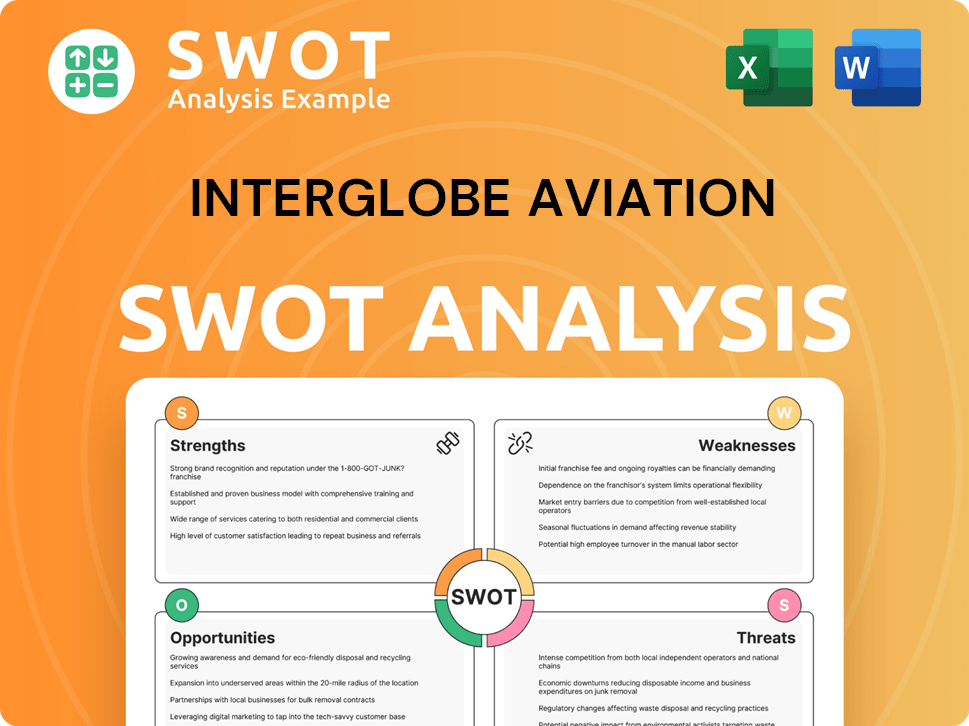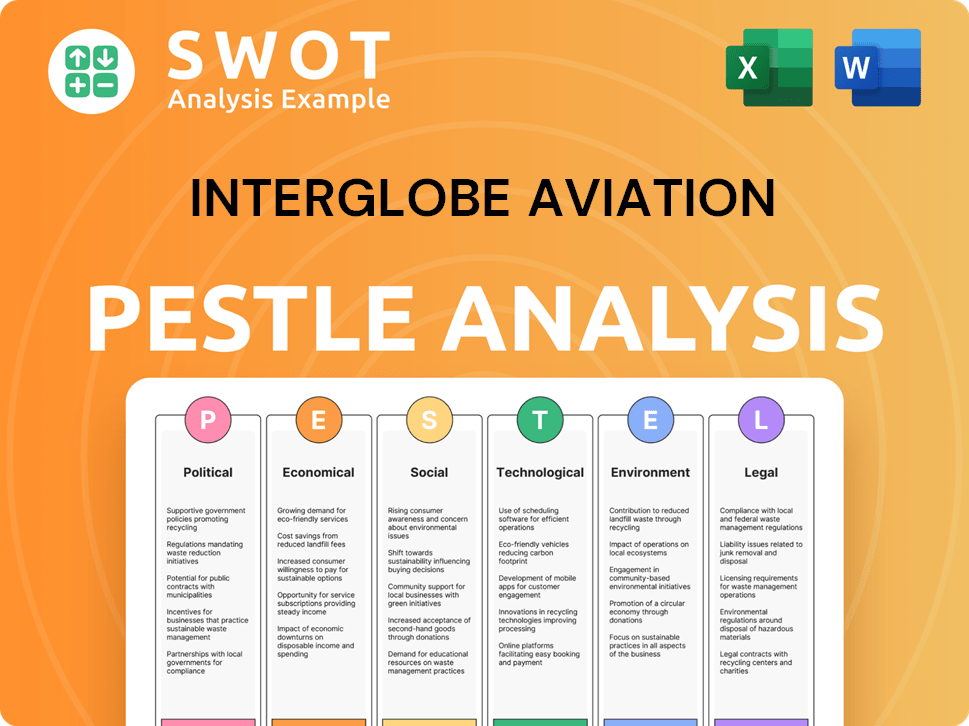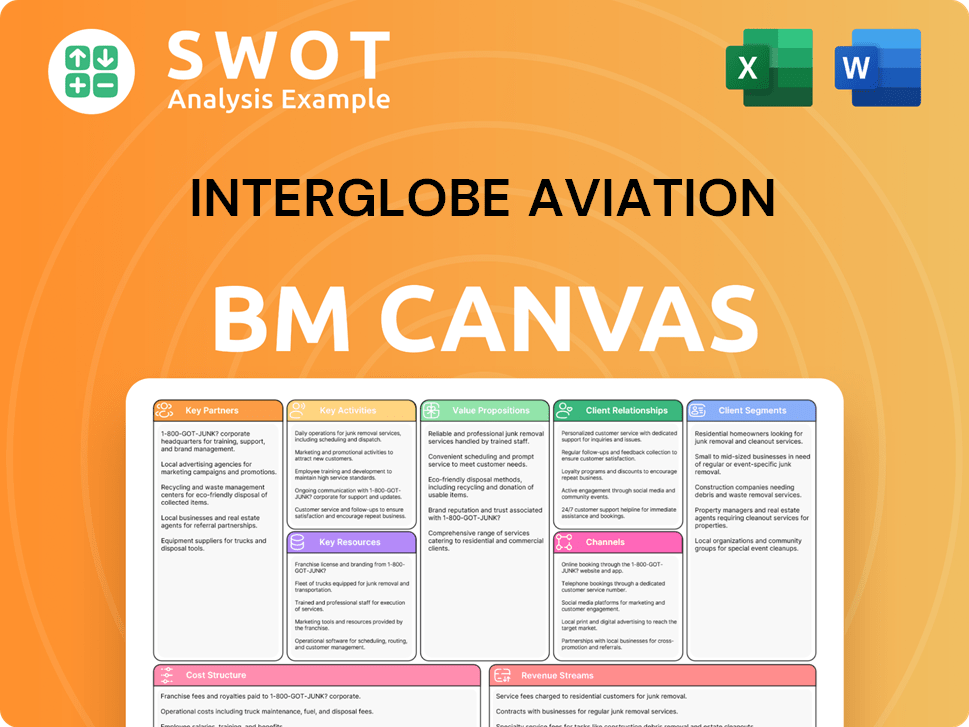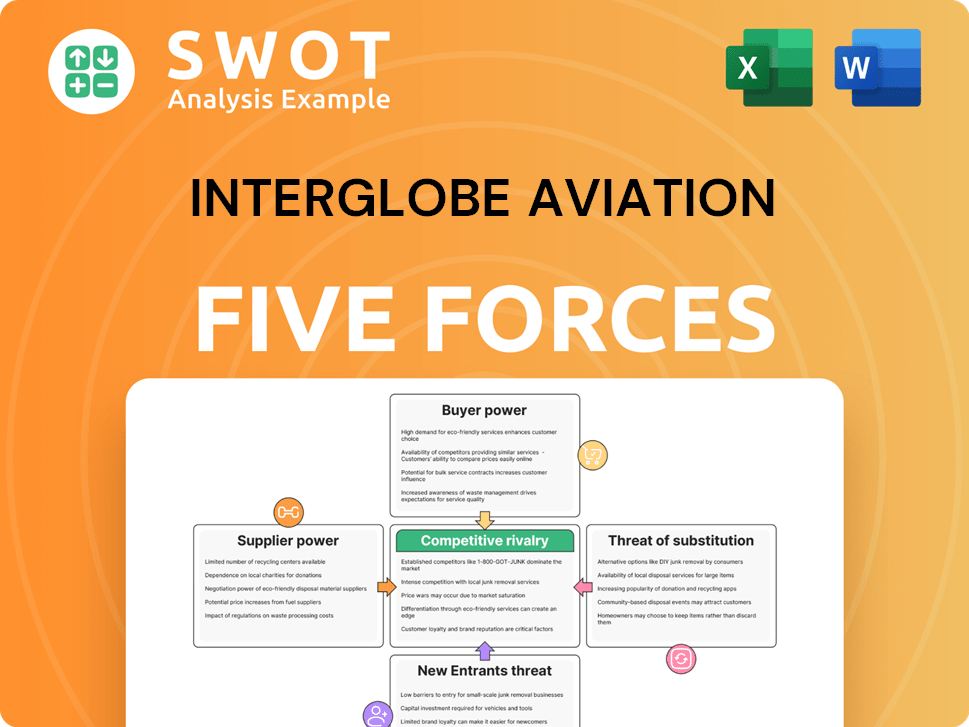InterGlobe Aviation Bundle
How is InterGlobe Aviation Redefining India's Skies?
Since its 2006 launch, IndiGo, or InterGlobe Aviation, has revolutionized air travel in India, becoming a dominant force in the InterGlobe Aviation SWOT Analysis. But how did it achieve such remarkable growth, and what does the future hold for this aviation giant? This analysis explores the strategic decisions that propelled IndiGo to the forefront of the Aviation Industry and unveils its ambitious plans for sustained expansion.

This deep dive into InterGlobe Aviation's growth strategy will provide a comprehensive market analysis, examining its competitive advantages and potential challenges. We'll explore the future prospects of Indigo Airlines, including its route expansion strategy and financial performance, to understand how it plans to maintain its leading position. Furthermore, the study will consider the impact of fuel prices and sustainability initiatives on the company's long-term growth strategy.
How Is InterGlobe Aviation Expanding Its Reach?
InterGlobe Aviation, operating primarily as IndiGo, is heavily focused on expanding its operations. This expansion strategy is designed to capitalize on the growing demand within India's aviation market and to diversify its revenue streams. The company's approach involves a combination of increasing its flight network, growing its fleet, and forming strategic alliances.
A key element of IndiGo's growth strategy is the expansion of its flight network, both domestically and internationally. The airline is actively adding new routes to various destinations, including Tier 2 and Tier 3 cities within India. Simultaneously, it is increasing its presence in international markets by launching new flights and increasing the frequency of existing routes. This dual approach allows IndiGo to capture a wider customer base and enhance its market share.
The airline's fleet expansion is another crucial aspect of its growth strategy. IndiGo has a significant order book for new aircraft, primarily from the Airbus A320neo family. This expansion ensures it has the capacity to support its planned route expansions and modernize its fleet. As of March 2024, IndiGo's fleet comprised 367 aircraft, demonstrating its commitment to sustained growth and market leadership.
IndiGo is focused on strengthening its presence in Tier 2 and Tier 3 cities. This strategy aims to tap into the growing air travel demand in these regions, which are experiencing economic growth and increasing connectivity. The airline is adding new routes and increasing flight frequencies to these cities to cater to the rising passenger traffic.
The airline is aggressively expanding its international footprint. Recent announcements include new direct flights to destinations such as Bali, Jakarta, and Phuket. Additionally, IndiGo is increasing flight frequencies on existing international routes to meet growing demand and enhance its global presence. This expansion is crucial for diversifying revenue streams and attracting a broader customer base.
IndiGo is significantly expanding its fleet to support its ambitious growth plans. With a substantial order book for Airbus A320neo family aircraft, the airline is ensuring it has the capacity to handle future expansions and modernize its fleet. This investment in new aircraft is essential for maintaining operational efficiency and providing a comfortable travel experience for passengers.
IndiGo is exploring strategic partnerships to enhance its market position and operational capabilities. These partnerships may involve code-sharing agreements, joint ventures, or other collaborative initiatives. Such alliances can help the airline expand its network, improve customer service, and optimize resource utilization, contributing to its overall growth strategy.
The future prospects for IndiGo, under InterGlobe Aviation, appear promising, driven by the continued growth in the Indian aviation market and its strategic expansion initiatives. The airline's focus on low-cost operations, fleet expansion, and route diversification positions it well for sustained growth. However, the aviation industry faces challenges such as fluctuating fuel prices and intense competition, which could impact profitability. The airline's ability to manage these factors will be crucial for its long-term success.
- Continued domestic expansion, especially in Tier 2 and Tier 3 cities.
- Further international route additions to diversify revenue streams.
- Ongoing fleet modernization and expansion to enhance operational efficiency.
- Strategic partnerships to strengthen market presence and improve service offerings.
InterGlobe Aviation SWOT Analysis
- Complete SWOT Breakdown
- Fully Customizable
- Editable in Excel & Word
- Professional Formatting
- Investor-Ready Format

How Does InterGlobe Aviation Invest in Innovation?
InterGlobe Aviation, operating primarily as Indigo Airlines, strategically uses innovation and technology to boost its operational efficiency, improve customer experience, and maintain its cost leadership within the Aviation Industry. Their approach involves significant investments in digital transformation, which is a key component of their Growth Strategy. This focus allows them to streamline processes and adapt to changing market dynamics.
The airline's commitment to technology is evident in its adoption of fuel-efficient aircraft like the Airbus A320neo. This not only reduces fuel costs but also lowers the environmental impact, aligning with sustainability goals. Data analytics plays a crucial role in optimizing flight schedules and personalizing customer offerings, contributing to a more efficient and customer-centric operation.
Indigo Airlines focuses heavily on on-time performance, which is a key differentiator in the competitive aviation market. This is supported by robust operational technology and processes. While specific details on R&D spending are not always publicly available, the airline's consistent focus on these areas indicates a strategic commitment to technological advancement.
The airline invests in mobile applications for booking and check-in, and self-service kiosks at airports to improve passenger flow. These tools streamline operations and enhance the overall customer experience. This digital focus is a core part of their strategy.
Indigo Airlines uses fuel-efficient aircraft, such as the Airbus A320neo, to reduce fuel consumption and lower operational costs. This also helps in reducing the environmental footprint, supporting sustainability goals. This is a key aspect of their operational strategy.
Data analytics is used to optimize flight schedules and manage crew rostering. It also helps in personalizing customer offerings. This data-driven approach enhances efficiency and customer satisfaction.
Indigo Airlines focuses on on-time performance through robust operational technology and processes. This emphasis on efficiency is a key factor in its competitive advantage. This is vital for maintaining customer trust.
The airline uses technology to improve the overall customer experience, from booking to boarding. Self-service options and mobile applications are central to this. This focus helps retain customers.
Technology and innovation are used to reduce operational costs, contributing to the airline's cost leadership. Fuel efficiency and streamlined processes are key to this. This helps maintain profitability.
Indigo Airlines' approach to technology and innovation is multifaceted, focusing on enhancing operational efficiency and improving customer service. The airline’s investments in digital transformation, fuel-efficient aircraft, and data analytics are central to its competitive strategy. These strategies are crucial for the company's long-term growth.
- Digitalization: Mobile apps, self-service kiosks, and online platforms for booking and check-in.
- Fleet Modernization: Utilizing fuel-efficient aircraft to reduce costs and environmental impact.
- Data Analytics: Optimizing flight schedules, crew management, and personalized customer offers.
- Operational Excellence: Maintaining high on-time performance through robust operational technology.
- Customer Experience: Enhancing the overall travel experience through technology-driven solutions.
For a deeper understanding of how InterGlobe Aviation approaches its marketing strategies, including the use of technology to reach its target audience, you can read more in this article about the Marketing Strategy of InterGlobe Aviation.
InterGlobe Aviation PESTLE Analysis
- Covers All 6 PESTLE Categories
- No Research Needed – Save Hours of Work
- Built by Experts, Trusted by Consultants
- Instant Download, Ready to Use
- 100% Editable, Fully Customizable

What Is InterGlobe Aviation’s Growth Forecast?
The financial outlook for InterGlobe Aviation, operating as IndiGo, is promising, largely due to strong passenger demand and ongoing expansion within the Target Market of InterGlobe Aviation. The airline's strategy focuses on maintaining its position as a low-cost carrier while expanding its network and enhancing operational efficiency. This approach supports its growth strategy and strengthens its competitive advantage in the Aviation Industry.
For the fiscal year ending March 31, 2024, InterGlobe Aviation demonstrated significant financial improvements. The company reported a substantial increase in net profit, reaching INR 8,172 crore. This is a notable turnaround from previous financial results. The airline's revenue from operations also saw a healthy increase, rising by 25.5% year-on-year to INR 68,905 crore.
IndiGo's financial health is further bolstered by its strong liquidity position and effective cost management. These factors are crucial for its financial resilience and ability to navigate market fluctuations. Analyst forecasts generally remain positive, predicting continued revenue growth and healthy profit margins as the Indian aviation market continues to expand. The company's substantial order book for new aircraft also signifies significant capital expenditure, which is expected to support long-term revenue generation and future expansion plans.
InterGlobe Aviation's revenue from operations grew by 25.5% year-on-year, reaching INR 68,905 crore for the fiscal year ending March 31, 2024. This substantial increase reflects the airline's ability to capitalize on the growing demand in the aviation market. The company's strategic focus on route expansion and capacity utilization contributed to this growth.
The airline reported a net profit of INR 8,172 crore for the fiscal year ending March 31, 2024, a significant improvement over previous periods. This profitability is a result of increased revenue, efficient cost management, and strategic pricing. This positive financial performance underscores the effectiveness of InterGlobe Aviation's business model.
Effective cost management is a key factor in IndiGo's financial resilience. The airline focuses on optimizing operational costs, including fuel, maintenance, and administrative expenses. This discipline allows IndiGo to maintain competitive pricing while ensuring profitability. This strategy is crucial for sustaining long-term growth.
IndiGo continues to expand its network, both domestically and internationally. This expansion strategy is supported by the airline's large order book for new aircraft, which will increase capacity and enable the exploration of new routes. This growth strategy is designed to capture a larger market share in India.
The future prospects for IndiGo are positive, with analysts anticipating continued revenue growth and healthy profit margins. The airline's strategic initiatives, including fleet expansion and cost optimization, are expected to support its long-term growth strategy. The aviation market's growth in India provides significant opportunities.
IndiGo's competitive advantage lies in its low-cost model, extensive network, and efficient operations. These factors enable the airline to offer competitive pricing while maintaining profitability. This advantage is crucial in the increasingly competitive aviation market. The company's focus on operational efficiency drives its success.
InterGlobe Aviation Business Model Canvas
- Complete 9-Block Business Model Canvas
- Effortlessly Communicate Your Business Strategy
- Investor-Ready BMC Format
- 100% Editable and Customizable
- Clear and Structured Layout

What Risks Could Slow InterGlobe Aviation’s Growth?
Despite its impressive expansion, InterGlobe Aviation, known for its Indigo Airlines, faces several potential risks and obstacles. The aviation industry is highly competitive, and various external factors can significantly impact the company's performance. Understanding these challenges is crucial for assessing the airline's long-term growth strategy and future prospects.
Intense competition, regulatory changes, and fluctuating fuel prices are among the key challenges. These factors can affect profitability and operational efficiency. Furthermore, the airline must navigate supply chain vulnerabilities and adapt to geopolitical and economic shifts to maintain its market position.
The re-emergence of competitors like Air India, now under the Tata Group, intensifies market competition, potentially leading to fare wars and margin pressures. Regulatory changes, including aviation policies, environmental norms, and taxation, could also impact operations and profitability. The company's ability to adapt to these challenges will be critical for its continued success.
The aviation industry is fiercely competitive, with numerous domestic and international carriers vying for market share. The entrance or resurgence of major players, such as Air India, increases competitive pressure. This can lead to fare wars, reduced profit margins, and the need for constant innovation to retain customers. Understanding the competitive landscape is vital for InterGlobe Aviation's growth strategy.
Changes in aviation policies, environmental regulations, and taxation can significantly impact the airline's operations and financial performance. New policies on fuel efficiency, carbon emissions, or airport infrastructure can increase costs. Compliance with evolving regulations requires continuous adaptation and investment, posing a challenge to maintaining profitability. The airline must proactively manage its response to these changes.
Fuel costs are a major operating expense for airlines, and their volatility can significantly affect profitability. Unexpected spikes in fuel prices can erode profit margins, necessitating hedging strategies and cost-saving measures. The airline needs to implement effective fuel management strategies to mitigate the risks associated with fluctuating fuel costs. The impact of fuel prices on the airline's financial performance is a constant concern.
Disruptions in the supply chain, particularly concerning aircraft spare parts and maintenance, can lead to operational delays and increased costs. Delays in obtaining essential components can ground aircraft, affecting flight schedules and customer satisfaction. The airline must ensure a resilient supply chain to minimize disruptions and maintain operational efficiency. Effective supply chain management is critical for avoiding operational setbacks.
Economic downturns and geopolitical instability can negatively affect air travel demand. Recessions can reduce discretionary spending on travel, leading to lower passenger numbers. Geopolitical events, such as conflicts or travel restrictions, can disrupt international routes and impact revenue. The airline needs to be prepared for economic fluctuations and geopolitical risks. Adapting to changing market conditions is crucial.
Operational disruptions, such as bad weather, airport congestion, or technical issues, can cause flight delays and cancellations. These disruptions can lead to increased costs, customer dissatisfaction, and damage to the airline's reputation. Implementing robust operational strategies and contingency plans is essential for minimizing the impact of such events. Effective operational management is key to maintaining reliability.
InterGlobe Aviation employs several strategies to mitigate these risks. These include a diversified route network, operational efficiencies, and a focus on cost leadership. The company also maintains a robust risk management framework, constantly monitoring market dynamics and adapting its strategies to address emerging challenges. For instance, the airline's strong operational performance has helped it navigate disruptions. In Q4 FY24, the airline's on-time performance was approximately 85%, a key indicator of its operational efficiency.
Continuous market analysis is crucial for understanding the competitive landscape and adapting to changing conditions. InterGlobe Aviation regularly assesses market trends, competitor strategies, and customer preferences. This helps the airline make informed decisions about route expansion, pricing, and service offerings. The airline's ability to adapt to market dynamics is essential for its long-term growth strategy. For example, in FY24, the airline added several new routes, demonstrating its proactive approach to market opportunities.
For additional insights into the core values and mission of InterGlobe Aviation, you can explore the article: Mission, Vision & Core Values of InterGlobe Aviation.
InterGlobe Aviation Porter's Five Forces Analysis
- Covers All 5 Competitive Forces in Detail
- Structured for Consultants, Students, and Founders
- 100% Editable in Microsoft Word & Excel
- Instant Digital Download – Use Immediately
- Compatible with Mac & PC – Fully Unlocked

Related Blogs
- What are Mission Vision & Core Values of InterGlobe Aviation Company?
- What is Competitive Landscape of InterGlobe Aviation Company?
- How Does InterGlobe Aviation Company Work?
- What is Sales and Marketing Strategy of InterGlobe Aviation Company?
- What is Brief History of InterGlobe Aviation Company?
- Who Owns InterGlobe Aviation Company?
- What is Customer Demographics and Target Market of InterGlobe Aviation Company?
Disclaimer
All information, articles, and product details provided on this website are for general informational and educational purposes only. We do not claim any ownership over, nor do we intend to infringe upon, any trademarks, copyrights, logos, brand names, or other intellectual property mentioned or depicted on this site. Such intellectual property remains the property of its respective owners, and any references here are made solely for identification or informational purposes, without implying any affiliation, endorsement, or partnership.
We make no representations or warranties, express or implied, regarding the accuracy, completeness, or suitability of any content or products presented. Nothing on this website should be construed as legal, tax, investment, financial, medical, or other professional advice. In addition, no part of this site—including articles or product references—constitutes a solicitation, recommendation, endorsement, advertisement, or offer to buy or sell any securities, franchises, or other financial instruments, particularly in jurisdictions where such activity would be unlawful.
All content is of a general nature and may not address the specific circumstances of any individual or entity. It is not a substitute for professional advice or services. Any actions you take based on the information provided here are strictly at your own risk. You accept full responsibility for any decisions or outcomes arising from your use of this website and agree to release us from any liability in connection with your use of, or reliance upon, the content or products found herein.